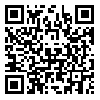BibTeX | RIS | EndNote | Medlars | ProCite | Reference Manager | RefWorks
Send citation to:
URL: http://irje.tums.ac.ir/article-1-5536-en.html
2- PhD Candidate in Health Education and Health Promotion, School of Health, Iran University of Medical Sciencesand Lecturer at Ardabil University of Medical Sciences, Ardabil, Iran ,
3- Ms in Sychology, School of Medicine, Ardabil University of Medical sciences, Ardabil, Iran
Background and Objectives: Lifestyle is one of the most important indicators of improving the quality of the people's lives. Given the key role of employees as valuable human resources, the aim of this study was to evaluate the lifestyle of the employees working in Ardabil University of Medical Sciences in 2015.
Methods: In this cross-sectional study, 320 employees working in Ardabil University of Medical Sciences were randomly included. The data collecting tools were a demographic form and the Walker questionnaire, which contained two questions related to the six dimensions of lifestyle. Data were analyzed with correlation tests, Chi-square, T-test, and Linear regression using SPSS.
Results: The lifestyle score was poor in 6.9%, moderate in 75.3%, and good in 17.8% of the employees. The mean and standard deviation of lifestyle dimensions was 22.19±4.9 for health responsibility, 27.93±5.2 for spiritual growth, 24.29±4.6 for interpersonal relations, 20.51±4.4 for stress management, 17.53±4.8 for physical activity, and 23.95±4.2 for nutrition. Women had higher scores than men in most items. There were significant relationships between gender and age with stress management (P=.002), gender and health responsibility (P=.002), educational level and health responsibility (P=.001), educational level and nutrition (P=.004), income and nutrition (P=.001), and educational level and interpersonal relations (P=.003).
Conclusion: The majority of employees their lifestyle was in the middle. The lowest score was related to physical activity and stress management. Interventions for promoting physical activity and stress management among employees is proposed.
Received: 2016/09/26 | Accepted: 2016/09/26 | Published: 2016/09/26
| Rights and permissions | |
 |
This work is licensed under a Creative Commons Attribution-NonCommercial 4.0 International License. |





